Key Takeaways:
Essential elements from Dropbox’s referral success story:
- They achieved 3900% user growth in 15 months
- Their referral program offered a natural extension of their product value
- They integrated referrals into the onboarding process
- They provided clear visibility of benefits
- They made it remarkably easy for users to invite friends
- They kept users informed of their referral status
- They engineered a viral loop that turned new users into referrers
What makes this Dropbox marketing so powerful is their universal applicability.
Whether you’re a B2B software company, a consumer brand, or a content creator, the core elements that drove Dropbox’s marketing success can be adapted to your specific context.
The Power of Referral Marketing in Today’s Digital Landscape
Before diving into Dropbox’s specific strategy, let’s contextualize why referral marketing has become such a powerful tool in the digital age.
In an era where consumers are bombarded with approximately 5,000 advertisements daily, traditional marketing approaches face increasing challenges in capturing authentic attention.
Referral marketing cuts through this noise by leveraging something far more valuable than any advertisement: trust.
When a recommendation comes from a friend or family member, it carries inherent credibility that no paid marketing can replicate.
Consider these referral marketing statistics:
- 92% of consumers trust recommendations from people they know more than any other form of advertising
- Referred customers have a 37% higher retention rate than customers acquired through other channels
- Referred customers have a 16% higher lifetime value than non-referred customers
- People are 4 times more likely to make a purchase when referred by a friend
These numbers explain why companies across industries have embraced referral marketing as a core business growth strategy.
But few have executed it as brilliantly as Dropbox, whose cloud storage solution revolutionized how people store and share files.
The Numbers That Matter: Dropbox’s Meteoric Rise
Dropbox’s referral program remains one of the most famous cases of referral marketing success.
Nearly 15 years later, it’s still featured in countless case studies showcasing how referral programs can become a company’s primary growth engine.
Let’s look at Dropbox’s remarkable trajectory:
September 2008: 100K registered users
December 2009: 4M registered users
January 2010: Users sending 2.8M invites per month
June 2011: 25M registered users
November 2012: 100M registered users
September 2017: 33.9M paying users (500M+ total users), $10B valuation + $1B Dropbox revenue
2023: $2.5B in revenue
Today: Over 700M registered users worldwide
What happened between 2008 and 2010? Dropbox managed to double its user base every three months, resulting in their users sending 2.8M invites in April 2010 alone.
We’re talking about a staggering 3900% growth in just 15 months!
Even more impressively, Dropbox achieved this remarkable growth with minimal marketing spend.
While their competitors were pouring millions into traditional advertising, Dropbox was growing exponentially through the power of word-of-mouth, systematized through their referral program.
Here’s Drew Houston’s presentation on how they used the lead startup approach:
The Context: Dropbox’s Pre-Referral Program Challenges
To fully appreciate the genius of Dropbox’s referral strategy, we need to understand the challenges they faced before implementing it.
Founded in 2007 by MIT graduates Drew Houston and Arash Ferdowsi, Dropbox entered a market that was already crowded with cloud storage solutions.
Tech giants like Google, Microsoft, and Apple were all working on their own cloud storage products, and numerous startups were competing in the same space.
Additionally, explaining the concept of cloud storage to average consumers in 2008 was challenging—many people were still using USB drives and emailing files to themselves as primary file transfer methods.
Dropbox had created an elegant solution to a common problem, but they faced several significant hurdles:
- High customer acquisition costs: Traditional digital advertising was expensive and inefficient for their target market
- Complex product explanation: The concept of seamless cloud storage was relatively new and difficult to explain in ads
- Trust barriers: Users needed to trust a new company with their important files
- Behavior change requirement: The product required users to change established file storage and file management habits
Traditional marketing wasn’t cutting it.
In fact, Dropbox found that the cost to acquire a customer through Google AdWords was between $233-$388, while their product only cost $99 per year. The economics simply didn’t work.
Drew Houston explained in a presentation at the 2010 Startup Lessons Learned conference that they needed a more cost-effective way to acquire users. Their solution? Turn their existing users into their marketing department.
How Dropbox’s Referral Program Worked (And Why It Was So Effective)
While Dropbox’s success wasn’t solely due to their referral program—they gathered extensive feedback, continuously improved their product, and fought hard for VC funding—their referral strategy was undeniably transformative.
The philosophy behind Dropbox’s program was brilliantly simple. Since they offered cloud storage space, they rewarded people with more free space not only for referring friends but also for accepting an invitation.
In other words, they created a two-sided referral program for a compelling product that rewarded both parties for completing the desired action: registering for Dropbox.
Here’s how the mechanics worked:
- Existing users received 500MB of free space for each friend who installed Dropbox (up to a maximum of 16GB)
- New referred users received 500MB of bonus space for signing up through a referral link (on top of the standard 2GB)
- Both parties benefited equally from the transaction
- The process was transparent, with users able to track their referral status
This structure was revolutionary at the time.
Here’s how it looked like before:
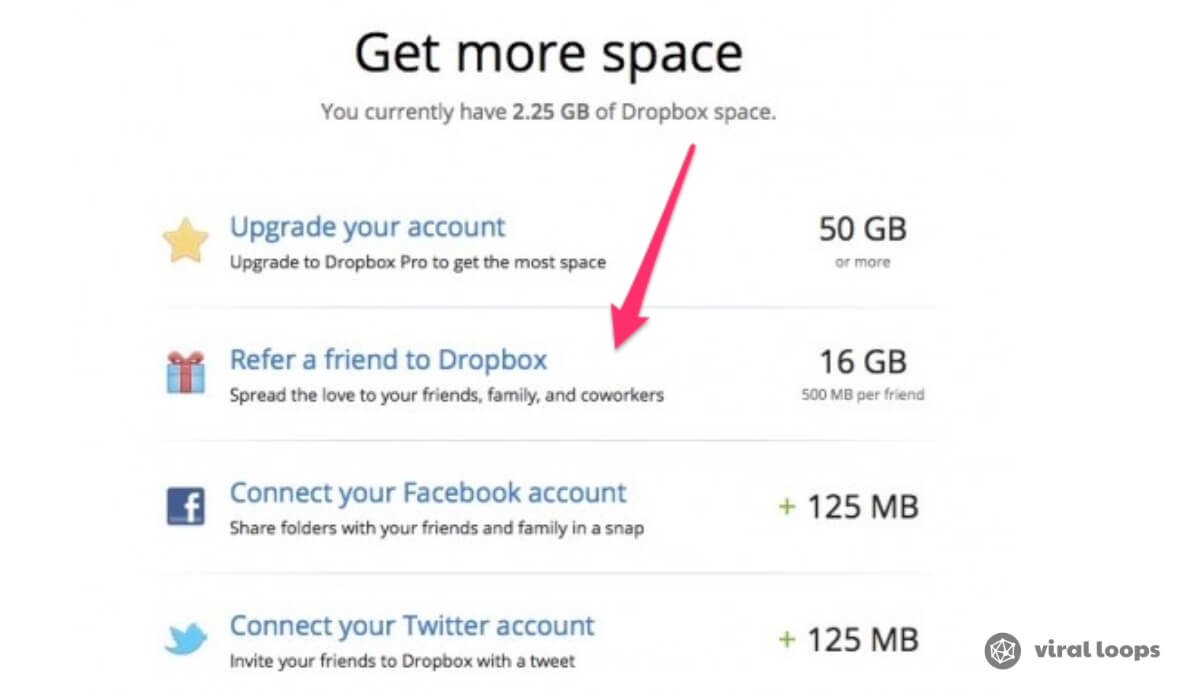
Let’s break down why it worked so well:
1. It Was Integrated Into the Onboarding Process
When people sign up for a new service, they expect to fill out some details. Dropbox made their onboarding process a six-step piece of cake and intelligently integrated their referral program as the final step.
It was like saying “thank you” by offering more of the product users already wanted. This timing was critical—users had just experienced the product’s value and were at their peak excitement.
The referral invitation came at precisely the right moment in the user journey:
- Users had just experienced the core product value — They understood what Dropbox did and how it could help them access files across multiple devices
- The “aha moment” was fresh in their minds — They had just experienced the simplicity of Dropbox’s file syncing
- The free storage limit was still top of mind — They were actively thinking about storage capacity
- No competing messages cluttered the experience — The referral offer stood out as a clear next step
By embedding the referral program directly into the onboarding flow, Dropbox ensured nearly 100% of new users were exposed to the referral opportunity. This placement maximized visibility without requiring additional marketing efforts.
2. Clear Visibility of Benefits and Rewards
According to founder Drew Houston, Dropbox’s referral program was inspired by PayPal’s refer-a-friend program.
While PayPal rewarded referrals with cash (aligning with their financial services), Dropbox used their product’s primary value in their rewarding system.
When someone decides to use a product, they know exactly what they want from it. For Dropbox users, that was cloud storage—the more, the better.
This is why, instead of generic “Invite your friends” messaging, Dropbox framed their referral program as “Get more space.”
This simple framing shift demonstrates why copywriting is one of the top marketing skills—context truly beats content.
The clarity extended to every aspect of the program:
- Precise reward amounts — Users knew exactly how much space they’d receive per referral
- Progress visualization — Users could see how much extra space they’d earned and how much more was available
- Clear maximum limits — The 16GB cap created a sense of scarcity and urgency
- Equal value exchange — Both parties received the same reward, creating a sense of fairness
This transparency eliminated confusion and friction that might have prevented participation. Users understood exactly what they were getting and what they needed to do to get it.
Author’s note: Here’s how the refer-a-friend section looks now:
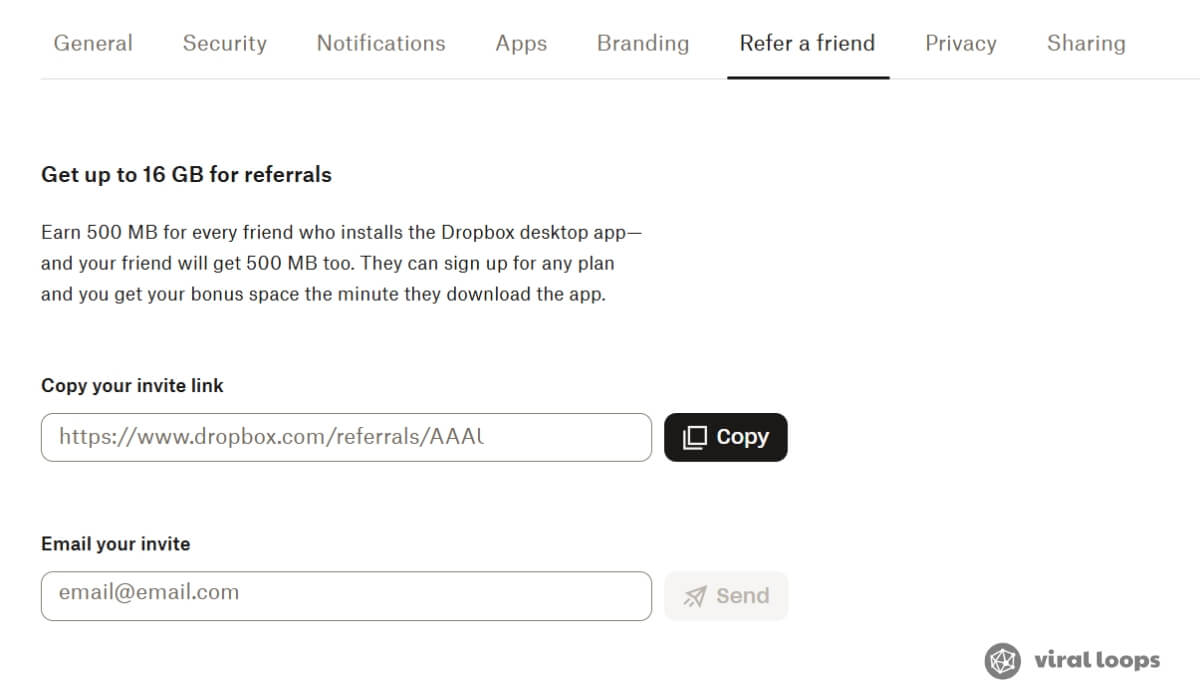
3. Frictionless Invitation Process
After hooking users with the “get more space” offer, Dropbox made it incredibly easy to achieve. Users could share via social media or by sending their unique referral link through any channel (messaging apps, email, SMS, etc.).
But here’s one of the most brilliant invitation hacks I’ve seen: recognizing that sending individual email invitations is tedious, Dropbox offered the option to sync contacts from Gmail, AOL, Yahoo!, and other providers.
This simple feature dramatically lowered the barrier to inviting multiple friends at once.
The invitation process was streamlined in several key ways:
- Multiple sharing options — Users could choose their preferred method of sharing
- Address book integration — One-click access to all contacts eliminated manual entry
- Personalization options — Users could customize the invitation message while keeping the core offer intact
- Persistent access — The referral page remained accessible throughout the user experience, not just during onboarding
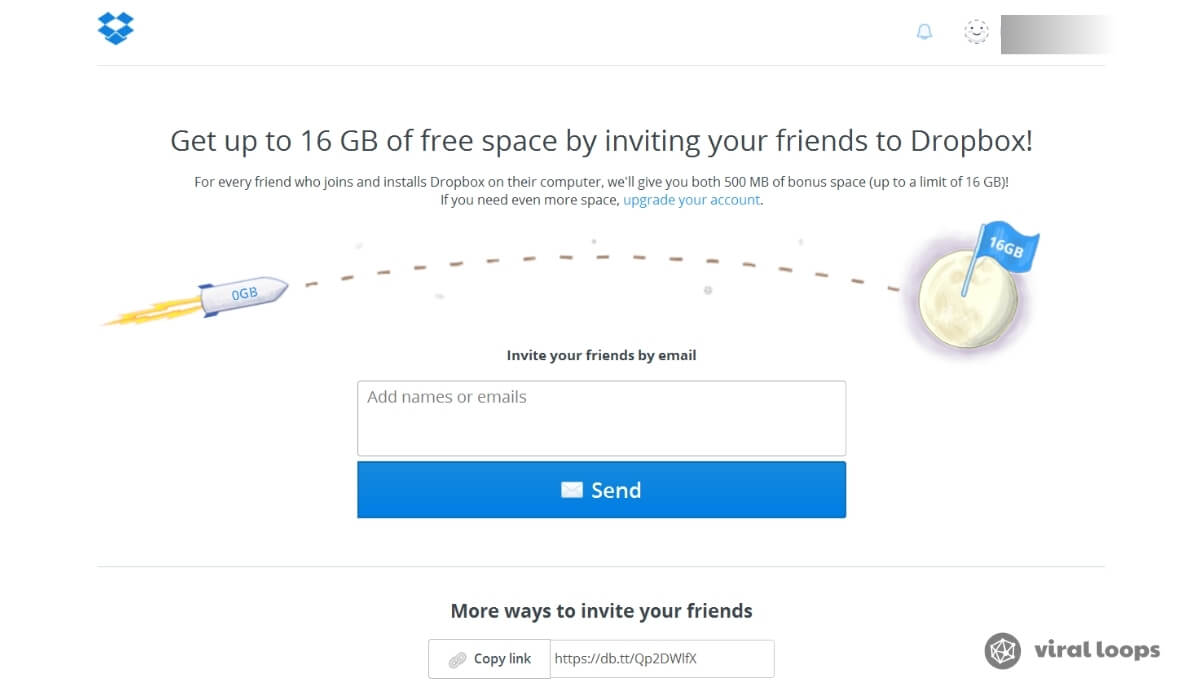
By reducing friction at every step of the sharing process, Dropbox maximized the number of invitations sent by each user. The easier it was to share, the more likely users were to participate.
4. Transparent Referral Status Tracking
If you’re planning to create a referral program, this point is crucial: users need to see how close they are to achieving their goals.
Many referral campaigns fall short here—users complete the steps, invite friends, and then… nothing! No notifications or updates on how their invites performed.
Dropbox avoided this pitfall by providing an accessible panel where users could track their invites and rewards in real-time, keeping them engaged with the referral process.
This monitoring tool, often called the Dropbox dash by marketing professionals, became a key engagement feature.
![]()
The tracking dashboard showed:
- Total space earned through referrals — Motivating users by showcasing their progress
- Number of successful referrals — Creating a sense of accomplishment
- Remaining potential rewards — Encouraging continued participation
- Status of pending invitations — Reducing uncertainty about the process
This transparency served multiple purposes. It satisfied users’ curiosity about their referral status, created accountability for the program, and most importantly, gamified the experience by showing progress toward the maximum reward.
5. A Perfectly Engineered Viral Loop
I personally became a Dropbox user through a referral. After signing up via a friend’s link, I received an email informing me I’d been granted 500MB of extra space for accepting the invitation.
The brilliance was in what came next—the same email included a P.S.: “To get even more space, invite your friends or upgrade your Dropbox,” with two clearly placed links.
Dropbox capitalized on my moment of delight by immediately offering additional value without requiring payment.
The goal wasn’t immediate revenue but expanding their user base in a cost-effective way by demonstrating their willingness to offer more for less—a strategy that paid off exponentially.
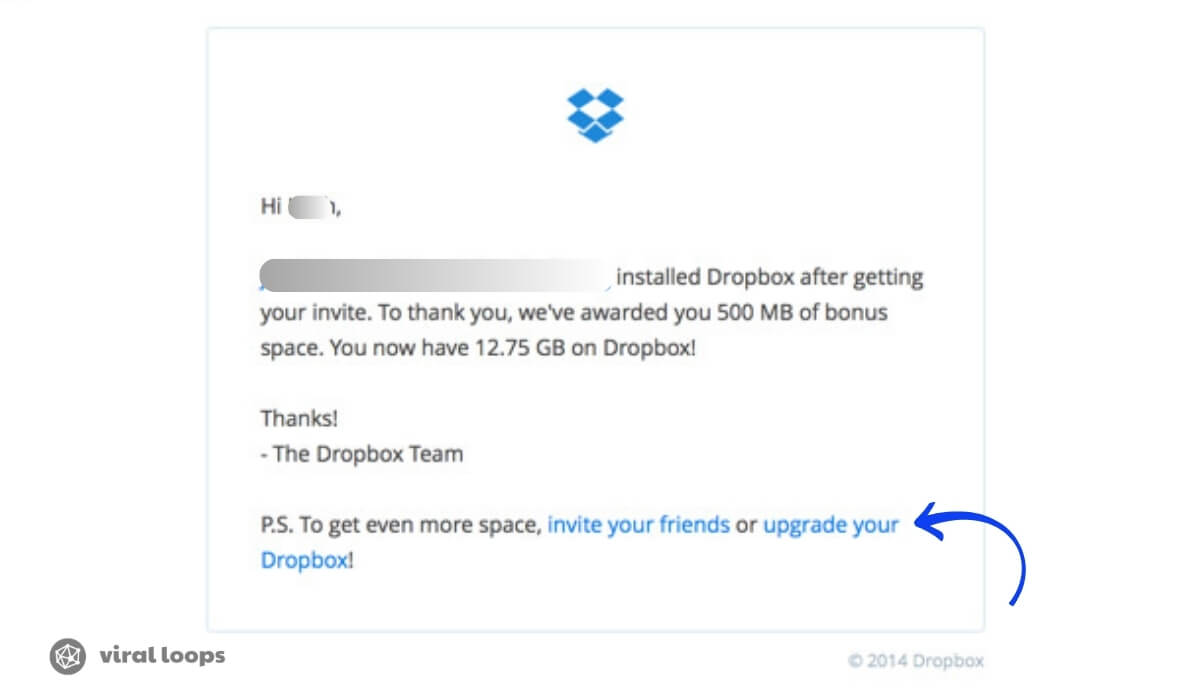
This viral loop consisted of several critical elements:
- Immediate gratification — New users received their bonus immediately, creating positive reinforcement
- Clear next steps — The referral call-to-action was presented as the logical next action
- Timing optimization — The invitation to refer others came when new users were most excited about the product
- Double incentive structure — Both the referrer and referee benefited, creating a win-win scenario
This carefully engineered loop turned new users into advocates almost instantly, creating a self-sustaining growth machine that required minimal ongoing investment from Dropbox.
Beyond the Basics: Additional Factors That Made Dropbox’s Referral Program Exceptional
While the five core elements above form the foundation of Dropbox’s referral success, several additional factors contributed to the program’s extraordinary impact:
The Product Was Inherently Shareable
Dropbox’s product itself naturally encouraged sharing. Users were already sending file links to colleagues and friends, which created organic opportunities to introduce new users to the platform.
The referral program simply formalized and incentivized something many users were already doing naturally.
This alignment between product functionality and referral mechanics created a seamless experience that didn’t feel like marketing.
Instead, it felt like an extension of the core business value that Dropbox provided: efficient file storage and sharing capabilities.
The Reward Structure Scaled Perfectly
Dropbox’s decision to reward with storage space rather than monetary incentives was brilliantly cost-effective.
The marginal cost of providing additional storage to existing users was minimal compared to the value of acquiring new customers.
Furthermore, by capping the total referral reward at 16GB, Dropbox ensured that even the most successful referrers would eventually need to upgrade to a paid plan if they required more space.
This created a natural path to monetization without diminishing the value of the referral rewards.
Learn more about how to master referral rewards in this video 👇
Testing and Optimization Were Continuous
What many people don’t realize is that Dropbox’s referral program wasn’t a one-time implementation—it was continuously refined based on user behavior and performance data. The team regularly tested different:
- Reward amounts and structures
- Invitation messaging and interfaces
- Onboarding placements and flows
- Email communications and follow-ups
This commitment to optimization ensured the program remained effective even as the market evolved and user expectations changed.
The program we celebrate today was the result of numerous iterations and improvements over time.
The Timing Was Perfect
Dropbox launched their referral program at a time when social sharing was becoming mainstream but referral marketing was still relatively uncommon.
This timing allowed them to benefit from the novelty factor while leveraging emerging social media platforms for distribution.
Additionally, cloud storage was just beginning to enter the mainstream consciousness, creating an opportunity to capture new users who were hearing about the concept for the first time through trusted friends rather than advertisements.
The Long-Term Impact: How Referrals Shaped Dropbox’s Business
The referral program didn’t just drive short-term user acquisition—it fundamentally shaped Dropbox’s business in lasting ways:
A Foundation of Trust
By acquiring users through trusted referrals rather than advertisements, Dropbox built a user base with inherently higher trust levels. This trust translated into:
- Higher engagement rates
- Lower support requirements
- Greater openness to new features
- Stronger word-of-mouth beyond the formal referral program
This foundation of trust became a competitive advantage that was difficult for competitors to replicate, even those with larger marketing budgets.
A Community of Advocates
The referral program transformed ordinary users into active advocates with a vested interest in Dropbox’s success. These advocates didn’t just bring in new users—they also:
- Provided valuable product feedback
- Defended the brand against competitors
- Created tutorial content and use cases
- Formed the core of early product communities
This community of advocates became an invaluable asset during Dropbox’s growth phase and subsequent competition with tech giants entering the cloud storage space.
A Data-Driven Growth Culture
The success of the referral program established growth marketing as a core competency within Dropbox. The company continued to apply similar data-driven approaches to other aspects of their business, including:
- Feature development and prioritization
- Pricing strategy and packaging
- Enterprise sales and expansion
- International market entry
This growth-oriented culture, born from the referral program’s success, influenced Dropbox’s approach to product development and marketing for years to come.
Applying Dropbox’s Referral Marketing Lessons to Modern Businesses
While Dropbox’s referral program was launched over a decade ago, the core principles behind its success remain equally relevant today.
Here’s how contemporary businesses can apply these lessons:
Identify Your Product’s Inherent Value
The most successful referral programs reward users with more of what they already value about your product. Consider:
- What is the primary value users get from your product or service?
- Could more of that value serve as an effective reward?
- If not, what alternative reward would align closely with your core value proposition?
For SaaS products, this might be additional features, credits, or extended subscription periods. For e-commerce, it could be store credits or exclusive products. The key is aligning rewards with existing user motivations.
Map Your User Journey for Optimal Placement
As Dropbox demonstrated, timing is crucial for referral program success. Analyze your user journey to identify:
- When users experience their first “aha moment” with your product
- Points of highest satisfaction or excitement
- Natural sharing opportunities within the product experience
- Low-friction moments where a referral ask wouldn’t disrupt the experience
Positioning your referral program at these strategic moments will maximize participation rates without creating a negative user experience.
Design for Shareability and Social Proof
Modern referral programs need to leverage contemporary sharing habits and platforms:
- Ensure your referral messages include compelling social proof
- Optimize invitation templates for various platforms (messaging apps, email, social media)
- Consider how your brand will appear when shared in different contexts
- Enable easy tracking of referrals across devices and platforms
The more naturally your referral program fits into existing social sharing behaviors, the more likely users are to participate.
Create a True Two-Sided Value Exchange
Following Dropbox’s example, ensure both parties receive meaningful value:
- Balance rewards between referrers and new users
- Consider whether equal rewards make sense for your business model
- Test different reward structures to find the optimal balance
- Ensure the value exchange is clear and compelling for both parties
The two-sided reward structure is often what transforms a mediocre referral program into a viral growth engine.
How Viral Loops Makes Implementing Your Own Dropbox-Style Referral Program Easy
While Dropbox’s referral program required significant development resources back in 2008, modern tools like Viral Loops now make it possible to implement similar strategies without extensive technical investment.
Here’s how our platform enables businesses of all sizes to leverage the same principles that drove Dropbox’s success:
Streamlined Campaign Configuration
The days of building referral programs from scratch are over.
Viral Loops’ Campaign Wizard guides you through a step-by-step setup process that ensures all critical elements are properly configured:
- Two-sided reward structures that benefit both referrers and friends
- Custom messaging that aligns with your brand voice and value proposition
- Tracking parameters that accurately attribute referrals across channels
- Integration points that connect seamlessly with your existing tech stack
This systematic approach distills the months of development Dropbox invested into a process that can be completed in hours, not weeks or months.
Customizable Templates for Diverse Business Models
Just as Dropbox tailored its referral program to its specific audience of file-sharing users, Viral Loops provides specialized templates for different business models:
- Refer-A-Friend Template: Perfect for software companies looking to replicate Dropbox’s approach with feature-based or subscription rewards
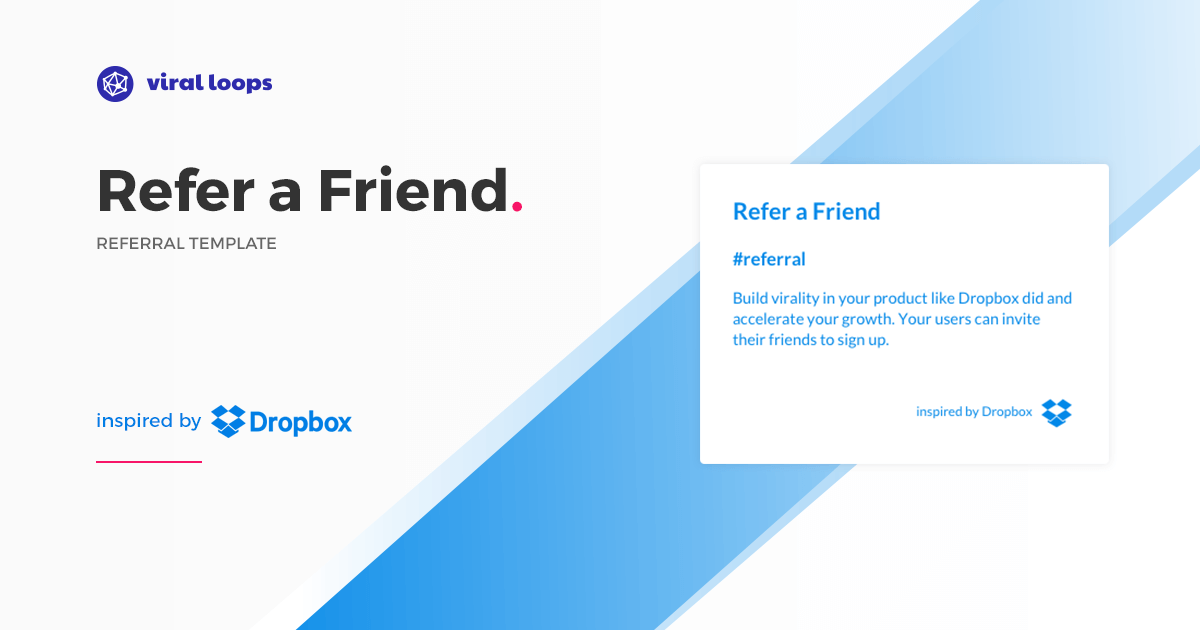
- Milestone Template: Ideal for pre-launch campaigns inspired by Harry’s successful approach
- Newsletter Template: Optimized for content creators looking to grow their subscriber base through referrals
- Universal Template: Works for any type of business, allowing you to build a custom referral program with ease
Each template incorporates the proven structural elements that made Dropbox’s program successful while allowing for customization based on your specific business model and audience.
No-Code Landing Page Solutions
One of the biggest barriers to implementing effective referral programs is creating the necessary user interfaces. Viral Loops Pages offers a codeless solution for creating referral campaign landing pages:
- Drag-and-drop interface for creating professional referral hubs
- Mobile-optimized designs that work across all devices
- Customizable templates that match your brand identity
- Built-in analytics to track performance and conversion rates
This feature democratizes the kind of viral growth Dropbox achieved, allowing businesses of any size to launch professional referral programs without technical expertise.
Seamless System Integration
A challenge that even Dropbox faced in its early days was connecting referral data with other business systems. Viral Loops solves this through robust integration capabilities:
- Direct connections with popular e-commerce platforms like Shopify and WooCommerce
- API integrations with leading CRM systems including Salesforce and HubSpot
- Email marketing platform connections with Mailchimp, ActiveCampaign, and others
- Custom webhook support for proprietary systems and unique workflows
These integrations ensure that referral program participants can be immediately engaged through your existing marketing channels, similar to how Dropbox maintained communication with its growing user base.
Advanced Analytics and Optimization
The kind of detailed analytics that helped Dropbox optimize its referral program comes standard with Viral Loops:
- Real-time dashboard showing key performance metrics
- Viral coefficient calculations to measure true viral growth
- Referral source tracking to identify your most valuable channels
- Conversion funnel analysis to identify and eliminate drop-off points
This immediate feedback allows for quick optimization of reward structures and messaging, much like how Dropbox continuously refined its program based on user response.
Frictionless Referral Experience
Like Dropbox’s original program, Viral Loops emphasizes making the referral process as frictionless as possible:
- One-click sharing options across multiple platforms
- Automated reward distribution when referral conditions are met
- Clear participant communications about referral status and rewards
- Cross-device tracking to maintain attribution regardless of how friends sign up
This automation helps create the seamless experience that made Dropbox’s referral program so successful, where users could easily track their rewards and continue sharing with friends.
Try Viral Loops for free and boost your company’s growth like how Dropbox did it.
Getting Started: Your Roadmap to Referral Marketing Success
Ready to implement your own Dropbox-inspired referral program?
Here’s a step-by-step roadmap to get you started:
1. Audit Your Current User Experience
Before designing your referral program, map your existing user journey to identify:
- Natural sharing moments within your product or service
- Points of highest user satisfaction or excitement
- Existing user behaviors that could be incentivized
This foundation will inform the optimal placement and structure of your referral program.
It’s also essential to audit your support resources—company helpdesks or knowledge bases should be equipped to answer referral program questions.
2. Define Your Two-Sided Value Proposition
Determine what rewards will motivate both existing users and their friends:
- What aspects of your product or service do users value most?
- What incentives would be cost-effective for your business while valuable to users?
- How can you create a win-win scenario for all participants?
The strength of your value proposition will directly impact participation rates.
3. Design Your Referral Flow
Create a frictionless referral experience by considering:
- How users will access the referral program
- What sharing options you’ll provide
- How you’ll track and attribute referrals
- How you’ll communicate successful conversions
Remember, every added step reduces participation rates.
4. Set Up Your Technology
Whether you’re building in-house or using a platform like Viral Loops, ensure your technology can:
- Track referrals accurately across devices and channels
- Distribute rewards automatically when conditions are met
- Provide participants with clear status updates
- Generate data insights for ongoing optimization
The right technology infrastructure will make or break your program’s success.
5. Launch, Monitor, and Optimize
Once your program is live:
- Track key metrics like participation rate, sharing rate, and conversion rate
- Test different messaging, reward structures, and sharing channels
- Gather user feedback on the referral experience
- Make data-driven adjustments to improve performance
Remember that even Dropbox’s legendary program was the result of continuous refinement. The company managed to stay focused on delivering value while improving their program through the early days of their growth.
Conclusion: Your Growth Engine Awaits!
Dropbox’s referral program didn’t just change the trajectory of one company—it revolutionized how businesses think about growth.
By transforming users into advocates and creating a self-perpetuating acquisition engine, Dropbox demonstrated that the most powerful marketing channel isn’t a platform you rent but a community you build.
Today, with tools like Viral Loops, implementing your own version of this growth engine is more accessible than ever.
The question isn’t whether referral marketing works—Dropbox and countless others have definitively answered that—but rather how you’ll adapt these proven principles to your unique business context.
Your customers are already talking about your brand. A strategic referral program simply gives them a reason, a method, and a reward for turning those conversations into conversions.
In a digital landscape where trust is the ultimate currency, there’s no more valuable marketing asset than a satisfied customer empowered to become your advocate.
Still on the fence? Why not Book a Demo and see how Viral Loops can boost your growth.
If these caught your attention and you’d love to read more referral marketing success stories, we recommend you check these:
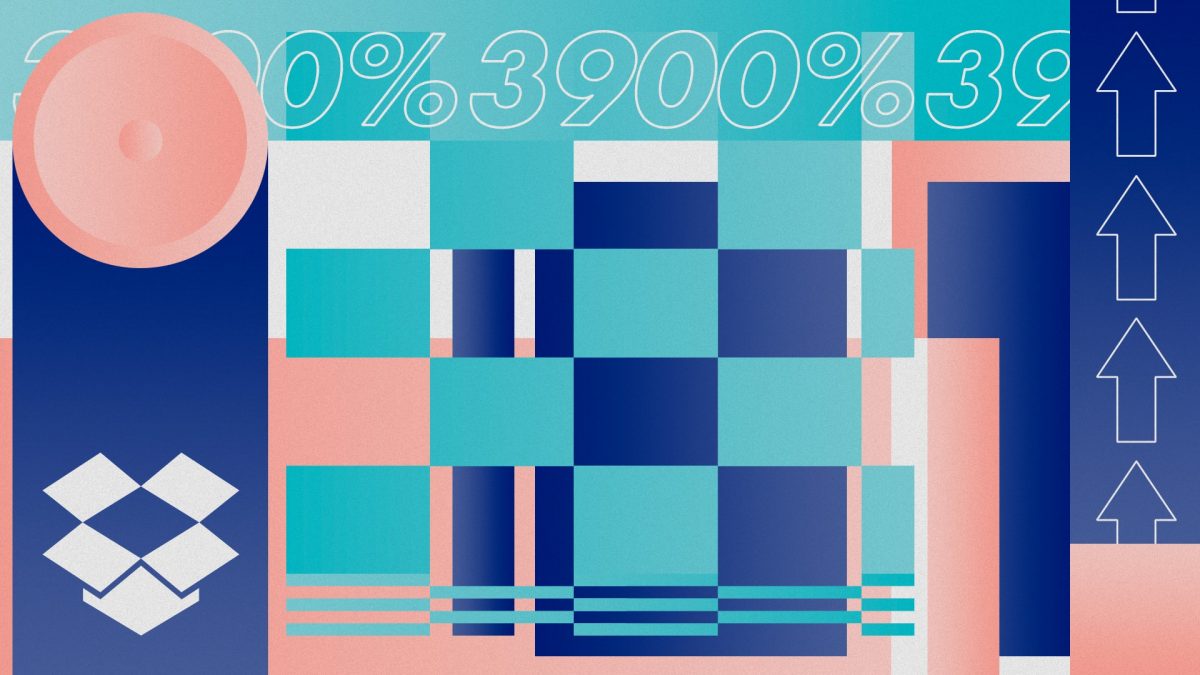
9 comments
Hello
Do you have an option to automatically synch customer emails to send out viral message like it was with DROPBOX?
“Email is powerful, but sending your invitations to contacts one by one isn’t so, Dropbox offered the option to sync your contacts from Gmail, AOL, Yahoo!, etc.”
Looking forward.
Thank you
Br,
Tomass